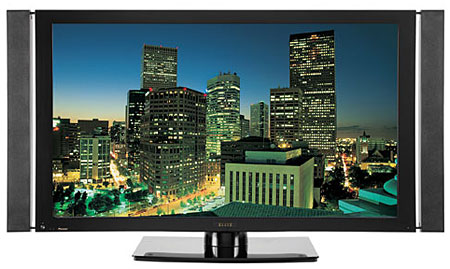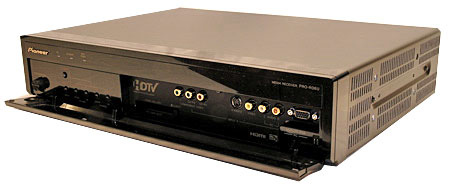Pioneer Elite PRO-1130HD Plasma Display System

Pioneer has certainly managed to do so in the performance department. But even at its new, much more attractive price, the Pioneer Elite is expensive compared with much of the competition. Do you get your money's worth?
A Two-Piece Suite
As with the PRO-1120HD, the PRO-1130HD locates its television tuner and all source connections (with a few exceptions) in a separate Media Receiver. The receiver is equipped with both DTV (HDTV) and standard definition (NTSC) tuners, and has its own model designation, the PRO-R06U. The panel has its own designation as well—the PRO506PU—but the two pieces are not available separately.
This two-box design may seem awkward, but if you hang your plasma on the wall, with the rear of the set inaccessible once it's in place, you'll appreciate the benefits. You'll still have some wires to contend with from the panel, including a power cord, connections to the speakers (which come detached from the set and can be mounted on its sides), and control and video signal cables from the Media Receiver. The cables included with the system are relatively short. If you have the receiver placed a significant distance from the display, you'll need to buy a longer set from your dealer or Pioneer.
The input and output complement of the Media Receiver is virtually identical to that of the receiver that came with the PRO-1120HD, as are many of the system's other features.
Two of the inputs accept HDMI or component connections, but not both. This limits you to a total of two HDMI or component sources. The set has CableCARD capability. A separate PC Card slot allows you to display most digital photographs using an adapter for your digital camera's memory card. Two i.LINK (IEEE 1394) inputs are provided for use with compatible sources (such as D-VHS recorders).
There's also a TV Guide On Screen Program Guide, which takes 17 pages of explanation in the manual! Sorry, but I'd rather use my cable box with its own easy-to-understand program guide and built-in high-definition DVR.
The Media Receiver has two antenna terminals. Only Antenna A, however, will accept DTV and HDTV sources.
There's the usual set of video adjustments, including five picture modes for AV sources: Standard, Dynamic, Movie, Game, User, and Pure. The user may change the video settings for each of these, except Dynamic. There are two additional modes, also called Standard and User, for a computer source.

A Pro Adjust selection in the Picture menu provides many of the less frequently used controls. There are two types of noise reduction controls: DNR (Digital Noise Reduction) and MPEG NR (for mosquito noise), which occasionally proved useful. PureCinema engages 3:2 pulldown for film-based material (Standard setting) or turns it off (Off).
PureCinema also has a third option: ADV (ADVanced). As with Standard, ADV is also intended for film-based material, but with an important difference. Film material is (usually) created at 24fps (frames per second), but all video sources convert this to 30fps because that's the video standard to which most video displays are built. It performs this conversion by using a 3:2 pulldown process. (Very simply put, 3:2 pulldown involves taking the original 24fps image, interlacing it, and duplicating and combining interlaced fields to generate the extra frames required for a 30fps rate.) ADV does away with 3:2 pulldown. Instead, it takes a converted 30 frames-per-second film-based video source and reconstructs it to 24fps. It then flashes each frame of that 24fps source three times per second for a refresh rate of 72 Hz—a refresh rate that the PRO-1130HD is designed to handle. In theory at least, this should provide considerably smoother motion, less flicker, and fewer motion artifacts (the technique is sometimes referred to as 3:3 pulldown.)
But there's an important limitation to this ADV mode, and it's not addressed in the manual. The set's processing must be able to sense the presence of 3:2 pulldown in the source. Only then can it perform the so-called reverse 3:2 pulldown to strip out the extraneous video fields and recreate a properly matched 24fps data stream. But the processing cannot recognize 3:2 pulldown in a progressive source. If you use ADV with 480p or 720p, the processing will get confused. You'll still get a picture, but it may be inferior the one you'll get by simply turning PureCinema to Off.
In short, ADV should be used only for film-based sources, and then only if those sources are either 480i or 1080i when they arrive at the Pioneer's inputs. If you use ADV with your DVD player, for example, leave the player set to 480i. I found ADV's visible benefits relatively subtle, but it produced no negative effects as long as I used it with interlaced, film-based sources.
Pro Adjust also provides six color temperature settings, including a user-adjustable Manual setting offering full calibration control (in the user menu) over red, green, and blue at both the high and low ends of the brightness range.

A color management option allows separate control over the six primary and secondary colors (red, green, blue, yellow, cyan, and magenta). I've never found such controls useful, particularly without test instruments to tell you what's happening (the same applies to the Manual color temperature controls). I recommend leaving them in their default, middle positions.
Other Pro Adjust controls, none of which I found particularly helpful in anything but their Off or default positions, were Dynamic Contrast, Black Level, ACL (according to the manual, this "performs such compensation that results in the optimum contrast characteristics for images"), Gamma (I left this at 2 most of the time), 3DYC (a comb filter, which is applicable only to composite video sources), CTI (Color Transient Improvement, said to provide "clearer color contours"), and I-P (interlace to progressive; I left it on the Standard setting of 2.)
Like the 1120HD, there's also a hidden and lockable ISF mode that may be accessed by a calibrator with the appropriate test equipment. Once it's set up, this ISF mode will appear as a selection in the user menu.
There are also myriad adjustments for sound, which are useful only if you use Pioneer's speakers. I did not test them.
Four aspect ratio settings are available for video sources: 4:3, Full, Zoom, Cinema, and Wide. Full is for anamorphic images (so-called enhanced for widescreen DVDs and most HDTV). Zoom is for blowing up standard (non-enhanced) letterbox images to fill the screen from left to right. Cinema is for 14:9 program material (at 1.56:1 a puzzling choice with a puzzling name, since that isn't exactly a common aspect ratio for films.) Wide is a non-proportional stretch mode (less stretch in the middle, more at the sides) that fills the 16:9 screen with a 4:3 source. As such stretchy modes go it's better than most, not as good as some.
The remote is nearly identical to that in the PRO-1120HD. Although it's backlit, some of the buttons are not visible in the dark, even with the backlighting. There are direct-access buttons for the input sources. It can control four different devices (TV, cable/satellite, VCR, and DVD/DVR), and is programmable either by inputting the correct codes or using its learning capability.
Inside
The PRO-1130's plasma panel is slightly more compact than its predecessor's, due mainly to a slimmer bezel. Signature Pioneer technologies are carried over from the earlier design. Key among them is the Deep Encased Cell Structure (deeper individual cells for more phosphor area and better isolation between the individual cells for better focus), and a First Surface Pure Color Filter (bonding the plasma color filter directly to the front glass rather than to a second glass layer, eliminating the extra reflections caused by two glass layers used in most other plasma displays.)
ACE IV (Advanced Continuous Emission IV) technology employs 10-bit, all-digital video processing. While consumer video sources are limited to 8 bits, there are technical benefits to up converting this native bit depth and making more bits available for processing. ACE IV also has none of the internal conversions from digital-to-analog and back (assuming a digital video input) that Pioneer says are used by other plasma sets.
The major new wrinkle in the PRO-1130HD is the Crystal Emissive Layer, sandwiched between the plasma cells and the front glass. It's claimed to improve brightness and contrast while lowering power consumption.
A League of Its Own?
The PRO-1130HD is capable of revealing the limitations of standard-definition material. But unlike some high-definition displays, it doesn't make such low resolution programming painful to watch. The noise reduction adjustments were useful here. Even with high-definition material NR reduced occasional, barely perceptible graininess in HD cable broadcasts without seriously compromising the detail I expect from high-definition programming.
- Log in or register to post comments




















































